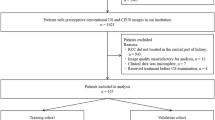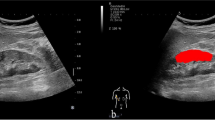Abstract
Objectives
To establish a simple-to-use nomogram based on quantification of color Doppler sonography data from a region of interest (ROI) to diagnose minimal change disease (MCD) promptly and non-invasively, and to evaluate the prediction capability of the nomogram.
Methods
We recruited 564 patients with pathology-proven renal disease who were admitted to our hospital from July 2020 to July 2021 (388 patients in the training dataset and 176 patients in the validation dataset), and their color Doppler sonography data were acquired from a ROI and underwent ipsilateral renal biopsy. The collected clinical features and ultrasonic features were imported into Rstuido and statistically significant features were selected by stepwise regression using the forward–backward method. Multivariate Logistic regression analysis was combined with clinical analysis to obtain the final modeling features. General and dynamic nomogram models were constructed with the selected features, depending on whether they were MCD or not. Bootstrapping and internal validation were used for internal and external validation of the nomogram, respectively. The performance of the nomogram was assessed by C-index, calibration curve, and receiver operating characteristic (ROC) curve.
Results
Age and VI were independent factors in predicting MCD. The value of Age (Best cut-off value: 33.5 years) combined with VI (Best cut-off value: 40.50 points) in the diagnosis of MCD was significantly higher than that of single diagnosis (AUC 0.901, 95% CI 0.863–0.938). The C-index of the nomogram constructed with age and VI in the training and validation datasets was 0.915 [95% confidence interval (CI) 0.874–0.956 and 0.875 95% CI 0.783–0.967], respectively. Calibration curves were fitted well. The sensitivity, specificity, and accuracy were 76.1%, 95.6%, and 78.3%, respectively, in the training dataset, and 74.1%, 94.4%, and 76.1% in the validation dataset, respectively.
Conclusion
The nomogram constructed with age and VI showed a satisfactory degree of differentiation and accuracy, which is of great significance for early, non-invasively, and individually analysis of the risk of MCD.
Graphical abstract









Similar content being viewed by others
Abbreviations
- ROI:
-
A region of interest
- MCD:
-
Minimal change disease
- ROC:
-
Receiver operating characteristic
- CI:
-
Confidence interval
- NS:
-
Nephrotic syndrome
- MN:
-
Membranous nephropathy
- IgAN:
-
IgA nephropathy
- FSGS:
-
Focal segmental glomerulosclerosis
- MPGN:
-
Membranoproliferative glomerulonephritis
- HSPN:
-
Henöch–Schönlein purpura nephritis
- DN:
-
Diabetic nephropathy
- LN:
-
Lupus nephritis
- AKI:
-
Acute kidney injury
- VI:
-
Vascular index
- FI:
-
Flow index
- VFI:
-
Vascularization-flow index
- CKD:
-
Chronic kidney disease
- eGFR:
-
Estimated glomerular filtration rate
- BMI:
-
Body mass index
- sAlb:
-
Serum albumin
- BUN:
-
Blood urea nitrogen
- sCr:
-
Serum creatinine
- UA:
-
Uric acid
- TC:
-
Total cholesterol
- TG:
-
Triglyceride
- 24hTP:
-
24-h uric total protein
- PGN:
-
Primary glomerulonephritis
- SGN:
-
Secondary glomerulopathy
References
Floege J, Amann K(2016)Primary glomerulonephritides. Lancet 387(10032):2036-2048. https://doi.org/10.1016/s0140-6736(16)00272-5.
Vivarelli M, Massella L, Ruggiero B, Emma F(2017) Minimal Change Disease. Clin J Am Soc Nephrol 12(2):332-345. https://doi.org/10.2215/cjn.05000516.
Jefferson JA, Nelson PJ, Najafian B, Shankland SJ(2011) Podocyte disorders: Core Curriculum 2011. Am J Kidney Dis 58(4):666-677. https://doi.org/10.1053/j.ajkd.2011.05.032.
Keskar V, Jamale TE, Kulkarni MJ, Kiggal Jagadish P, Fernandes G, Hase N(2013) Minimal-change disease in adolescents and adults: epidemiology and therapeutic response. Clin Kidney J 6(5):469-472. https://doi.org/10.1093/ckj/sft063.
Takei T, Koike M, Suzuki K, Shirota S, Itabashi M, Ohtsubo S, et al(2007)The characteristics of relapse in adult-onset minimal-change nephrotic syndrome. Clinical and experimental nephrology 11(3):214-217. https://doi.org/10.1007/s10157-007-0484-5.
Lee H, Yoo K, Oh Y, Kim D, Oh K, Joo K, et al(2016) Predictors of Relapse in Adult-Onset Nephrotic Minimal Change Disease. Medicine 95(12):e3179. https://doi.org/10.1097/md.0000000000003179.
Rovin BH, Adler SG, Barratt J, Bridoux F, Burdge KA, Chan TM, et al(2021) Executive summary of the KDIGO 2021 Guideline for the Management of Glomerular Diseases. Kidney Int 100(4):753-779. https://doi.org/10.1016/j.kint.2021.05.015.
AlYousef A, AlSahow A, AlHelal B, Alqallaf A, Abdallah E, Abdellatif M, et al(2020) Glomerulonephritis Histopathological Pattern Change. BMC Nephrol 21(1):186. https://doi.org/10.1186/s12882-020-01836-3.
Lionaki S, Mantios E, Tsoumbou I, Marinaki S, Makris G, Liapis G, et al(2021) Clinical Characteristics and Outcomes of Adults with Nephrotic Syndrome Due to Minimal Change Disease. Journal of clinical medicine 10(16). https://doi.org/10.3390/jcm10163632.
Wu F, Zhang Y, Cui W, Dong Y, Geng Y, Liu C, et al(2021)Development and validation of a discrimination model between primary PLA2R-negative membranous nephropathy and minimal change disease confirmed by renal biopsy. Scientific reports 11(1):18064. https://doi.org/10.1038/s41598-021-97517-8.
Liu L, Wang H, Zhao B, Liu X, Sun Y, Mao Y(2022) Nomogram to predict the progression of patients with primary membranous nephropathy and nephrotic syndrome. International urology and nephrology 54(2):331-341. https://doi.org/10.1007/s11255-021-02859-x.
Cameron J, Hicks J(2002) The origins and development of the concept of a "nephrotic syndrome". American journal of nephrology 22:240-247. https://doi.org/10.1159/000063768.
Hu R, Quan S, Wang Y, Zhou Y, Zhang Y, Liu L, et al(2020)Spectrum of biopsy proven renal diseases in Central China: a 10-year retrospective study based on 34,630 cases. Sci Rep 10(1):10994. https://doi.org/10.1038/s41598-020-67910-w.
Xu X, Ning Y, Shang W, Li M, Ku M, Li Q, et al(2016) Analysis of 4931 renal biopsy data in central China from 1994 to 2014. Renal failure 38(7):1021-1030. https://doi.org/10.1080/0886022x.2016.1183443.
Yang Y, Zhang Z, Zhuo L, Chen DP, Li WG(2018)The Spectrum of Biopsy-Proven Glomerular Disease in China: A Systematic Review. Chin Med J (Engl) 131(6):731-735. https://doi.org/10.4103/0366-6999.226906.
Okpechi I, Swanepoel C, Duffield M, Mahala B, Wearne N, Alagbe S, et al(2011)Patterns of renal disease in Cape Town South Africa: a 10-year review of a single-centre renal biopsy database. Nephrology, dialysis, transplantation : official publication of the European Dialysis and Transplant Association - European Renal Association 26(6):1853-1861. https://doi.org/10.1093/ndt/gfq655.
Pepe F, Pepe P(2013) Color Doppler ultrasound (CDU) in the diagnosis of obstructive hydronephrosis in pregnant women. Arch Gynecol Obstet 288(3):489-493. https://doi.org/10.1007/s00404-013-2768-1.
Scholbach T, Wang H, Yang A, Loong C, Wu T(2013) Correlation of histopathologic and dynamic tissue perfusion measurement findings in transplanted kidneys. BMC nephrology 14:143. https://doi.org/10.1186/1471-2369-14-143.
Scholbach T(1999)Color Doppler sonographic determination of renal blood flow in healthy children. Journal of ultrasound in medicine : official journal of the American Institute of Ultrasound in Medicine 18(8):559-564. https://doi.org/10.7863/jum.1999.18.8.559.
Scholbach T(2001)Changes of renal flow volume in the hemolytic-uremic syndrome--color Doppler sonographic investigations. Pediatric nephrology (Berlin, Germany) 16(8):644-647. https://doi.org/10.1007/s004670100638.
Sobh M, El Kannishy G, Moustafa F, Eid R, Hamdy N, Tharwat S(2022) Role of detached podocytes in differentiating between minimal change disease and early focal segmental glomerulosclerosis, can we rely on routine light microscopy? Journal of nephrology 35(9):2313-2324. https://doi.org/10.1007/s40620-022-01456-0.
da Silva C, Monteiro M, Araújo L, Urzedo M, Rocha L, Dos Reis M, et al(2020) In situ evaluation of podocytes in patients with focal segmental glomerulosclerosis and minimal change disease. PloS one. 15(11):e0241745. https://doi.org/10.1371/journal.pone.0241745.
Tang L, Cai Z, Wang S, Zhao W(2022) Transition from minimal change disease to focal segmental glomerulosclerosis related to occupational exposure: A case report. World journal of clinical cases 10(17):5861-5868. https://doi.org/10.12998/wjcc.v10.i17.5861.
Acknowledgements
None
Funding
The author(s) received no financial support for the research, authorship, and/or publication of this article.
Author information
Authors and Affiliations
Corresponding author
Ethics declarations
Conflict of interest
The author(s) declared no conflicts of interest with regard to the research, authorship, and/or publication of this article.
Ethical approval
This study was approved in all participating by our Hospital Human Ethics Committee. The ethics number was QYFYWZLL26599. The study followed the ethical principles of the Declaration of Helsinki 1964.
Additional information
Publisher's Note
Springer Nature remains neutral with regard to jurisdictional claims in published maps and institutional affiliations.
Rights and permissions
Springer Nature or its licensor (e.g. a society or other partner) holds exclusive rights to this article under a publishing agreement with the author(s) or other rightsholder(s); author self-archiving of the accepted manuscript version of this article is solely governed by the terms of such publishing agreement and applicable law.
About this article
Cite this article
Ma, L., Zhang, Y., Zhang, L. et al. Development and validation of a simple-to-use nomogram for predicting minimal change disease based on quantification of color Doppler sonography data from a region of interest. Abdom Radiol 48, 1020–1032 (2023). https://doi.org/10.1007/s00261-022-03780-2
Received:
Revised:
Accepted:
Published:
Issue Date:
DOI: https://doi.org/10.1007/s00261-022-03780-2




